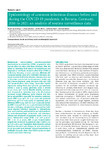2023-10-12Zeitschriftenartikel
Epidemiology of common infectious diseases before and during the COVID-19 pandemic in Bavaria, Germany, 2016 to 2021: an analysis of routine surveillance data
van der Berg, Sarah
Charles, Tanja
Dörre, Achim
Katz, Katharina
Böhm, Stefanie
Background
Unprecedented non-pharmaceutical interventions to control the COVID-19 pandemic also had an effect on other infectious diseases.
Aim
We aimed to determine their impact on transmission and diagnosis of notifiable diseases other than COVID-19 in Bavaria, Germany, in 2020 and 2021.
Methods
We compared weekly cases of 15 notifiable infectious diseases recorded in Bavaria between 1 January 2016 and 31 December 2021 in time series analyses, median age and time-to-diagnosis using Wilcoxon rank sum test and hospitalisation rates using univariable logistic regression during three time periods: pre-pandemic (weeks 1 2016–9 2020), pandemic years 1 (weeks 10–52 2020) and 2 (2021).
Results
Weekly case numbers decreased in pandemic year 1 for all diseases assessed except influenza, Lyme disease and tick-borne encephalitis; markedly for norovirus gastroenteritis (IRR = 0.15; 95% CI: 0.12–0.20) and pertussis (IRR = 0.22; 95% CI: 0.18–0.26). In pandemic year 2, influenza (IRR = 0.04; 95% CI: 0.02–0.09) and pertussis (IRR = 0.11; 95% CI: 0.09–0.14) decreased markedly, but also chickenpox, dengue fever, Haemophilus influenzae invasive infection, hepatitis C, legionellosis, noro- and rotavirus gastroenteritis and salmonellosis. For enterohaemorrhagic Escherichia coli infections, median age decreased in pandemic years 1 and 2 (4 years, interquartile range (IQR): 1–32 and 3 years, IQR: 1–18 vs 11 years, IQR: 2–42); hospitalisation proportions increased in pandemic year 1 (OR = 1.60; 95% CI: 1.08–2.34).
Conclusion
Reductions for various infectious diseases and changes in case characteristics in 2020 and 2021 indicate reduced transmission of notifiable diseases other than COVID-19 due to interventions and under-detection.

